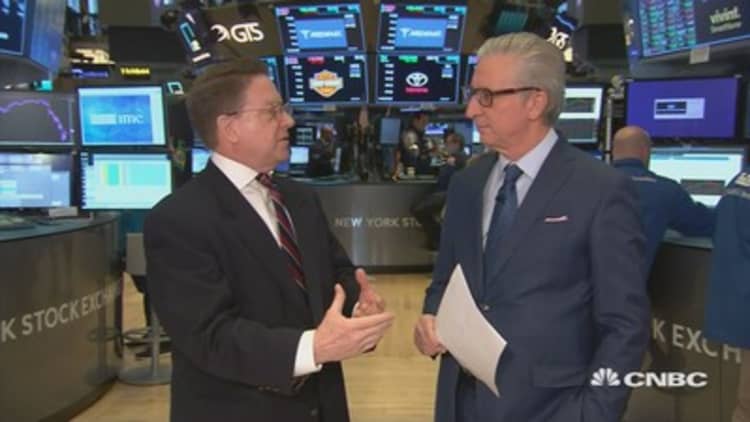
Stocks rebounded sharply from their worst week since the financial crisis on Monday, with the Dow Jones Industrial Average posting its best day in more than a decade. Expectations that the Federal Reserve would cut rates drove the gains, which accelerated aggressively into the close.
The Dow closed 1,293.96 points higher, or 5.1%, at 26,703.32. The move on a percentage basis was the Dow's biggest since March 2009. It was the largest-ever points gain for the 30-stock average.
The S&P 500 climbed 4.6% — its best one-day performance since Dec. 26, 2018 — to close at 3,090.23. The Nasdaq Composite also had its best day since 2018, surging 4.5% to 8,952.16.
Monday's gains snapped a seven-day losing streak for the Dow.
Apple shares led the Dow higher with a 9.3% jump; Merck and Walmart gained 6.3% and 7.6%, respectively. Utilities, tech, consumer staples and real estate all rose more than 5% to lead the S&P 500 higher.
The major averages were coming off a massive decline from the week before as worries over the coronavirus spreading dented investor sentiment.
"The market has been conditioned to buy on any weakness," said Keith Buchanan, portfolio manager at GLOBALT. "We've grown accustomed to bad days being followed by a few good days in a row."
The major averages had their worst weekly performance since 2008 last week and entered correction territory, down more than 10% from all-time highs set last month. On Monday, however, the Dow, S&P 500 and Nasdaq all closed out of correction. The Dow and Nasdaq were 9.7% and 9% below their respective record highs. The S&P 500 ended the day 8.9% below its all-time high.
But Peter Cardillo, chief market economist at Spartan Capital Securities, was skeptical the worst was over for the market.
"I wouldn't put too much into this," he said, noting longer-dated U.S. Treasurys are still trading near record levels as coronavirus fears persist. "Although I think we're getting close to putting in a bottom, I still think we need to drop another 2% to 3% to have some sort of capitulation."
More than 89,000 cases have been confirmed around the world along with more than 3,000 virus-related deaths. Australia, Thailand and the U.S. reported over the weekend their first coronavirus-related deaths. Rhode Island was the first U.S. state on the East Coast to report a coronavirus case.
The number of cases in England rose to 35 after 12 new cases were confirmed on Sunday. Cases in China also reported more than 500 new cases on Saturday. New York Gov. Andrew Cuomo confirmed Sunday night the state's first positive coronavirus case.
Horrible China economic data
Wall Street got its first look over the weekend at the economic toll the virus has taken on China, the epicenter of the outbreak.
A private survey on Chinese manufacturing activity released during Asian trading hours on Monday came in at its weakest level ever. The Caixin/Markit Manufacturing Purchasing Managers' Index (PMI) came in at 40.3 for February, far below expectations of a reading of 45.7 by economists in a Reuters poll. PMI readings above 50 indicate expansion, while those below that level signify a contraction.
That came after an official data released Saturday showed China's official manufacturing PMI plunging to 35.7 in February, a record low, from 50 in January. A reading below 50 indicates contraction in a sector.
The plunge "shows the extent to which an outbreak can hit an economy," said Ed Hyman, a widely followed economist on Wall Street and Evercore ISI chairman, in a note to clients. "All this is quite uncertain, and we may be overreacting. But we also don't want to underreact."
Gaming revenues in Macau also plunged nearly 88% last month.
Data out of the U.S. was also lackluster. The ISM manufacturing index fell to 50.1 in February, the lowest level since the end of 2019. It also came below an estimate of 50.8.
Worries over the coronavirus' impact on corporate profits and the global economy led investors to seek safer alternatives to stocks, pushing U.S. Treasury yields to all-time lows. On Sunday night, the benchmark 10-year rate broke below 1.04% for the first time ever. It was last at 1.14%.
"Global investors will be prone to panic as the virus arrives at their doorstep, underscoring the need for near-run prudence and patience before augmenting favored holdings," strategists at MRB Partners wrote in a note. "The outlook is uncertain, or rather certainly bearish in the near term as quarantining spreads around the world, but with considerable doubt as to the duration and depth of the economic fallout."
But at the end of the day, the weak data didn't matter as expectations increased for easier monetary policy from global central banks, including the Federal Reserve.
CME Group's FedWatch tool shows traders have priced in a 100% probability of a 50 basis-point rate cut later this month. Expectations for another rate cut in April are around 70%.
"The ultimate risk factor in our view is the U.S. consumer," said Gregory Faranello, head of U.S. rates trading at AmeriVet Securities. "We have coronavirus cases showing up in the U.S. To the extent that that continues to spread, which we all hope will not be the case, the risk factor for the Fed grows because this now is no longer something that they can point the finger to relative to tariffs and say the global economy is slow, but we're okay."
Subscribe to CNBC PRO for exclusive insights and analysis, and live business day programming from around the world.



